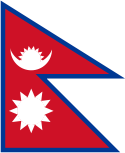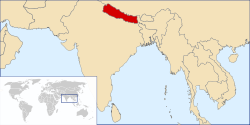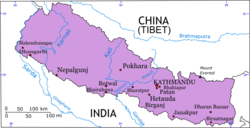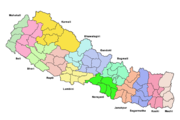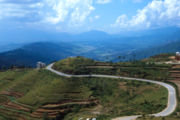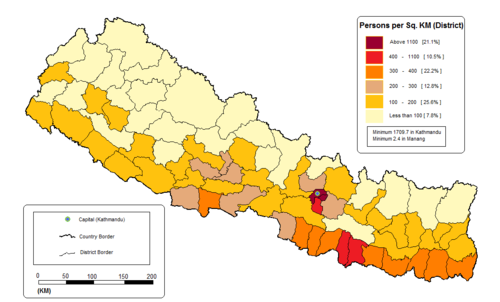Nepal
2008/9 Schools Wikipedia Selection. Related subjects: Asia; Asian Countries
| नेपाल Nepal |
||||||
|---|---|---|---|---|---|---|
|
||||||
| Motto: जननी जन्मभूमिष्च स्वर्गादपि गरीयसी (Sanskrit) "Mother and motherland are dearer than the heavens" |
||||||
| Anthem: Sayaun Thunga Phool Ka |
||||||
|
|
||||||
| Capital (and largest city) |
Kathmandu ( Nepal Bhasa: येँ) |
|||||
| Official languages | Nepali | |||||
| Demonym | Nepali | |||||
| Government | Interim government | |||||
| - | King | Gyanendra Bir Bikram Shah Dev | ||||
| - | Interim Head of State |
Girija Prasad Koirala | ||||
| - | Prime Minister | Girija Prasad Koirala | ||||
| Unification | December 21, 1768 | |||||
| - | Republic | December 28, 2007 | ||||
| Area | ||||||
| - | Total | 147,181 km² ( 93rd) 56,827 sq mi |
||||
| - | Water (%) | 2.8 | ||||
| Population | ||||||
| - | July 2007 estimate | 28,901,790 ( 40th) | ||||
| - | 2002 census | 23,151,423 | ||||
| - | Density | 184/km² ( 56th) 477/sq mi |
||||
| GDP ( PPP) | 2006 estimate | |||||
| - | Total | $41.18 billion ( 87th) | ||||
| - | Per capita | $1,500 ( 164rd) | ||||
| Gini (2003–04) | 47.2 (high) | |||||
| HDI (2007) | ▲ 0.534 (medium) ( 142nd) | |||||
| Currency | Rupee ( NRs.) |
|||||
| Time zone | NPT ( UTC+5:45) | |||||
| - | Summer ( DST) | not observed ( UTC+5:45) | ||||
| Internet TLD | .np | |||||
| Calling code | +977 | |||||
| 1 | The monarch's constitutional role as Head of State has been transferred to the Prime Minister until the Constituent Assembly election on April 10 decides on the monarchy's fate | |||||
Nepal ( Nepali: नेपाल [neˈpaːl] ) is a landlocked nation in South Asia, bordering the People's Republic of China (Tibet) to the north and India to the south, east and west.
Until 2006, Nepal, was officially the only Hindu state in the world. On May 18, 2006, Nepal was declared a secular state by the Interim Parliament of Nepal. On December 28, 2007, the interim parliament passed a bill and declared Nepal to be a federal democratic republic. The current king, Gyanendra Bir Bikram Shah Dev, will be the last king of Nepal if the present ruling parties win the April 2008 elections.
For a relatively small country, Nepal has a diverse landscape, ranging from the humid Terai plainlands in the south to the mountaneous Himalayas in the north. Eight of the world's top ten highest mountains, including Mount Everest, are in Nepal.
Etymology
The word “Nepal” has derived from the word “Nepa:” which refers to the Newar Kingdom of Kathmandu Valley and surrounding areas before the unification of Nepal. A calendar Nepal Sambat is still one of the major calendar used in Nepal, which was named after Newar kingdom of Kathmandu Valley called "Nepa:", and was devised 1100 years ago.
It is important to remember that the Kingdom of Kathmandu Valley was called “Nepa:” and the language of Newars was called Nepal Bhasa long before the unification of Nepal. After unification of Nepal, Shah King Prithivi Narayan Shah adopted the name Nepal for the entire country.
Various theories exist as to how the word Nepal evolved. According to one, Sage "Ne" ( Rishi) protected ("Pala" in Sanskrit) this land for long time so it is called "Nepal". Another legend ties the name to agriculture: "Ne" means wool in Tibetan language and "pal" means house or godown.
Language
Nepali is the national language of Nepal; it has evolved from various hilly dialects over the last five hundred years. It was called as Khas Kura, and has only recently been called as Nepali.
Nepal Bhasa is the language of Newars, who are native to Kathmandu Valley. Since Nepali does not have its own alphabet and uses devanagari, Government of Nepal had submitted alphabets of Nepal Bhasa (Ranjana Lipi) to United Nations while claiming its bid to be recognised as independent country.
One of the the first written inscriptions in Nepali is found in the writing on stone of King Pratap Malla(17th century). This written inscription is also the earliest prose written in "Nepali".
Political status
On December 28, 2007, the government proposed to amend Article 159 of the constitution and declare Nepal a federal republic, thereby abolishing the monarchy. As per the amendment, Article 159 of the interim constitution was amended - replacing "Provisions regarding the King" by "Provisions of the Head of the State."
If the parties present in current ruling coalition win the election for constituent assembly scheduled for April 2008, the current king, Gyanendra Bir Bikram Shah Dev shall give up the title and throne, making him the last ruling monarch and making Nepal a federal democratic state with an elected head of state.
History
Nepal is mentioned in Hindu scriptures such as the Narayana Puja and the Atharva Siras (800-600 BC). Neolithic tools found in the Kathmandu Valley indicate that people have been living in the Himalayan region for at least 9,000 years. It appears that people who were probably of Tibeto-Burman ethnicity lived in Nepal 2,500 years ago. Around 1000 BCE, small kingdoms and confederations of clans arose in the region. From one of these, the Sakya confederation, arose a prince named Siddharta Gautama (563–483 BCE), who later renounced his royalty to lead an ascetic life and came to be known as the Buddha ("the enlightened one"). By 250 BCE, the region came under the influence of the Mauryan empire of northern India, and later became a vassal state under the Gupta Dynasty in the fourth century CE. From the late fifth century CE, rulers called the Licchavis governed the area. The Licchavi dynasty went into decline in the late eighth century and was followed by a Newari era, from 879, although the extent of their control over the entire country is uncertain. By the late 11th century, southern Nepal came under the influence of the Chalukaya Empire of southern India. Under the Chalukayas, Nepal's religious establishment changed as the kings patronised Hinduism instead of the prevailing Buddhism.
By the early 12th century, leaders were emerging whose names ended with the Sanskrit suffix malla ("wrestler"). Initially their reign was marked by upheaval before the kings consolidated their power over the next 200 years. By the late 14th century much of the country began to come under a unified rule. This unity was short-lived; in 1482 the region was carved into three kingdoms: Kathmandu, Patan, and Bhadgaon.
After centuries of petty rivalry between the three kingdoms, in the mid-18th century Prithvi Narayan Shah, a Gorkha King set out to unify the kingdoms. Seeking arms and aid from India, and buying the neutrality of bordering Indian kingdoms, he embarked on his mission in 1765. After several bloody battles and sieges, he managed to unify Kathmandu Valley three years later in 1768. However, an actual battle never took place to conquer the Kathmandu valley; it was taken over by Prithvi Narayan and his troops without any effort, during Indra Jatra, a festival of Newars, when all the valley's citizens were celebrating the festival. This event marked the birth of the modern nation of Nepal. There is historical evidence that, at one time, the boundary of Greater Nepal extended from Tista River on the East to Kangara, across Sutlej River, in the west. A dispute and subsequently war with Tibet over the control of mountain passes forced the Nepalese to retreat and pay heavy repatriations. Rivalry between Nepal and the British East India Company over the annexation of minor states bordering Nepal eventually led to the Anglo-Nepalese War (1815–16). The valor displayed by the Nepalese during the war astounded their enemies and earned them their image of fierce and ruthless "Gurkhas". The war ended with a treaty, the Treaty of Sugauli. This treaty ceded Sikkim and lands in Terai to the Company. Some parts of Terai Region were given back to Nepal by British East India Company as a friendly gesture to Nepal because of her role to help maintain control of their regime in India during the so called Sepoy Rebellion of 1857. The decision to help British East India Company was taken by the Rana Regime, then led by Jang Bahadur Rana.
Factionalism inside the royal family had led to a period of instability. In 1846 a plot was discovered to overthrow Jang Bahadur, a fast-rising military leader by the reigning queen. This led to the Kot Massacre. Armed clashes between military personnel and administrators loyal to the queen led to the execution of several hundred princes and chieftains around the country. Bahadur emerged victorious and founded the Rana lineage. The king was made a titular figure, and the post of Prime Minister was made powerful and hereditary. The Ranas were staunchly pro-British, and assisted the British during the Sepoy Rebellion in 1857, and later in both World Wars. In 1923 the United Kingdom and Nepal formally signed an agreement of friendship, in which Nepal's independence was recognised by the UK.
In the late 1940s, newly emerging pro-democracy movements and political parties in Nepal were critical of the Rana autocracy. Meanwhile, with the annexation of Tibet by the Chinese in 1950, India faced the prospect of a military expansion of her Northern neighbour and was thus keen to avoid instability in Nepal. Forced to act, India sponsored both King Tribhuvan as Nepal's new ruler in 1951, and a new government, mostly comprising the Nepali Congress Party. After years of power wrangling between the king and the government, the democratic experiment was suppressed in 1959, and a "partyless" panchayat system was made to govern Nepal until 1989, when the "Jan Andolan" (People's) Movement forced the monarchy to accept constitutional reforms and to establish a multiparty parliament that took seat in May 1991.
In 1996, the Communist Party of Nepal (Maoist) started a bid to replace the parliamentary system with a socialist republic. This led to the Nepal Civil War and the deaths of more than 12,000. On June 1, 2001, the Heir Apparent Crown Prince Dipendra was accused of a massacre in the royal palace, a violent response to his parents' refusal to accept his choice of wife. After the massacre, the King and the Queen were among the dead and the Crown Prince as well having committed suicide. However, there are lots of speculations and doubts among Nepalease citizens about the person(s) responsible for the Royal Massacre. Following the carnage, the throne was inherited by Birendra's brother Gyanendra.On February 1, 2005, Gyanendra dismissed the entire government and assumed full executive powers to quash the Maoist movement. In September 2005, the Maoists declared a three-month unilateral ceasefire.
Following the 2006 democracy movement, the king agreed to relinquish the sovereign power back to the people and reinstated the dissolved House of Representatives on April 24, 2006. Using its newly acquired sovereign authority, on May 18, 2006, the newly resumed House of Representatives unanimously passed a motion to curtail the power of the king and declared Nepal a secular state. As of December 2007, a bill was passed in parliament which declared Nepal a "federal democratic republic" constitutionally.. The bill, however, will not come into force until immediately after the forthcoming elections of April 2008.
Geography
Geography of Nepal is uncommonly diverse. Nepal is of roughly trapezoidal shape, 800 kilometres (500 mi) long and 200 kilometres (125 mi) wide, with an area of 147,181 square kilometres (56,827 sq mi). Nepal is commonly divided into four physiographic areas: the Mountain, Hill, Siwalik region and Terai Regions. These ecological belts run east-west and are bisected by Nepal's major river systems. Nepal is roughly the same size in land area as the US states of Michigan and Arkansas or the UK state/country of England.
The southern lowland Plains bordering India are part of the northern rim of the Indo-Gangetic plains. They were formed and are fed by three major rivers: the Kosi, the Narayani (India's Gandak River), and the Karnali. This region has a hot, humid climate.
The Hill Region (Pahad) abuts the mountains and varies from 1,000 to 4,000 metres (3,300–13,125 ft) in altitude. Two low mountain ranges, the Mahabharat Lekh and Shiwalik Range (also called the Churia Range) dominate the region. The hilly belt includes the Kathmandu Valley, the country's most fertile and urbanised area. Unlike the valleys Called Inner Tarai (Bhitri Tarai Uptyaka) elevations above 2,500 metres (8,200 ft) are sparsely populated.
The Mountain Region contains the highest region in the world. The world's highest mountain, Mount Everest (Sagarmatha in Nepali) at 8,848 metres (29,028 ft) is located on the border with the autonomous region of China, Tibet. Seven more of the world's ten highest mountains are located in Nepal: Lhotse, Makalu, Cho Oyu, Kanchenjunga, Dhaulagiri, Annapurna and Manaslu. Deforestation is a major problem in all regions, with resulting erosion and degradation of ecosystems.
Nepal has five climatic zones, broadly corresponding to altitude. The tropical and subtropical zones lie below 1,200 metres (3,940 ft), the temperate zone 1,200 to 2,400 metres (3,900–7,875 ft), the cold zone 2,400 to 3,600 metres (7,875–11,800 ft), the subarctic zone 3,600 to 4,400 metres (11,800–14,400 ft), and the Arctic zone above 4,400 metres (14,400 ft). Nepal experiences five seasons: summer, monsoon, autumn, winter and spring. The Himalaya blocks cold winds from Central Asia in winter, and forms the northern limit of the monsoon wind patterns.
Although Nepal shares no boundary with Bangladesh, the two countries are separated by a narrow strip of land about 21 kilometre (13 mi) wide, called the Chicken's Neck. Efforts are underway to make this area a free-trade zone.
Situated in the Great Himalayan Range in Northern part of Nepal, Mount Everest has the highest altitude of any mountain in the world. Technically, the south-east ridge on the Nepali side of the mountain is easier to climb, so most climbers travel to Everest through Nepal. The Annapurna mountain range also lies in Nepal.
Zones, districts, and regions
Nepal is divided into 14 zones and 75 districts, grouped into 5 development regions. Each district is headed by a fixed chief district officer responsible for maintaining law and order and coordinating the work of field agencies of the various government ministries. The 14 zones are:
|
|
|
Economy
Agriculture sustains 76% of the population and accounts for about 40% of the GDP; services comprise 41%, and industry 22%. Nepal remains isolated from the world’s major land, air and sea transport routes though air traffic is frequent. Hilly and mountainous terrain in the northern two-thirds of the country has made the building of roads and other infrastructure difficult and expensive. There were just over 8,500 km of paved roads, and one 59 km railway line in the south in 2003. There is only one reliable road route from India to the Kathmandu Valley. The only practical seaport of entry for goods bound for Kathmandu is Kolkata in India. Internally, the poor state of development of the road system (22 of 75 administrative districts lack road links) makes volume distribution unrealistic.
Aviation is in a better state, with 48 airports, ten of them with paved runways. There is less than one telephone per 19 people; landline telephone services are not adequate nationwide but concentrated in cities and district headquarters; mobile telephony is in a reasonable state in most parts of the country with increased accessibility and affordability. There were around 175,000 Internet connections in 2005, but after the imposition of the "state of emergency", intermittent losses of service were reported. Uninterrupted Internet connections have resumed after the brief period of confusion as Nepal's second major people's revolution took place to overthrow the King's absolute power.
Its landlocked location and technological backwardness and the long-running civil war have also prevented Nepal from fully developing its economy. The country receives foreign aid from India, Japan, the United Kingdom, the United States, the European Union, China, Switzerland, and Scandinavian countries. The government's budget is about US$1.153 billion, with expenditures of $1.789bn (FY05/06). The inflation rate has dropped to 2.9% after a period of higher inflation during the 1990s. The Nepali Rupee has been tied to the Indian Rupee at an exchange rate of 1.6 for many years. Since the loosening of exchange rate controls in the early 1990s, the black market for foreign exchange has all but disappeared. A long-standing economic agreement underpins a close relationship with India.
The distribution of wealth among the Nepali is consistent with that in many developed and developing countries: the highest 10% of households control 39.1% of the national wealth and the lowest 10% control only 2.6%.
Nepal's workforce of about 10 million suffers from a severe shortage of skilled labour. Agriculture employs 81% of the workforce, services 16% and manufacturing/craft-based industry 3%. Agricultural produce——mostly grown in the Terai region bordering India——includes tea, rice, corn, wheat, sugarcane, root crops, milk, and water buffalo meat. Industry mainly involves the processing of agricultural produce, including jute, sugarcane, tobacco, and grain. The spectacular landscape and deep, exotic culture of Nepal represents considerable potential for tourism, but growth in this export industry has been stifled by recent political events. The rate of unemployment and underemployment approaches half of the working-age population. Thus many Nepali citizens move to India in search of work, the Gulf countries and Malaysia being new sources of work. Poverty is acute. Nepal receives US$50 million a year through the Gurkha soldiers who serve in the Indian and British armies and are highly esteemed for their skill and bravery. The total remittance value is worth around 1 billion USD, including money sent from Persian Gulf and Malaysia, who combined employ around 700,000 Nepali citizens.
Nepal's GDP for the year 2005 is estimated at just over US$39 billion (adjusted to Purchasing Power Parity), making it the 83rd-largest economy in the world. Per-capita income is less than US$ 300. Nepal's exports of mainly carpets, clothing, leather goods, jute goods and grain total $822 million. Import commodities of mainly gold, machinery and equipment, petroleum products and fertilizer total US$2 bn. India (53.7%), the US (17.4%), and Germany (7.1%) are its main export partners. Nepal's import partners include India (47.5%), the United Arab Emirates (11.2%), China (10.7%), Saudi Arabia (4.9%), and Singapore (4%).
Government and politics
Until 1990, Nepal was an absolute monarchy running under the executive control of the king. Faced with a people's movement against the absolute monarchy, King Birendra, in 1990, agreed to large-scale political reforms by creating a parliamentary monarchy with the king as the head of state and a prime minister as the head of the government.
Nepal's legislature was bicameral consisting of a House of Representatives called the Pratinidhi Sawa and a National Council called the Rastriya Sawa. The House of Representatives consists of 205 members directly elected by the people. The National Council had sixty members, ten nominated by the king, thirty-five elected by the House of Representatives and the remaining fifteen elected by an electoral college made up of chairs of villages and towns. The legislature had a five-year term, but was dissolvable by the king before its term could end. All Nepali citizens 18 years and older became eligible to vote.
The executive comprised the King and the Council of Ministers (the Cabinet). The leader of the coalition or party securing the maximum seats in an election was appointed as the Prime Minister. The Cabinet was appointed by the king on the recommendation of the Prime Minister. Governments in Nepal have tended to be highly unstable; no government has survived for more than two years since 1991, either through internal collapse or parliamentary dissolution by the monarch on the recommendation of prime minister according to the constitution.
The movement in April, 2006, brought about a change in the nation: an interim constitution was promulgated, with the King giving up power, and an interim House of Representatives was formed with Maoist members after the new government held peace talks with the Maoist rebels. The number of seats were also increased to 330. In April, 2007, the Communist Party of Nepal (Maoist) joined the interim government of Nepal.
On December 28, 2007, the interim parliament passed a bill that would make Nepal a federal republic, with the Prime Minister becoming head of state. The bill is yet to be passed by the Constituent Assembly.
Military and foreign affairs
Nepal's military consists of the Nepalese Army which includes the Nepalese Army Air Service, (the air force unit under it). Nepalese Police Force is the civilan police and the Armed Police Force Nepal is the paramilitary force. Service is voluntary and the minimum age for enlistment is 18 years. Nepal spends $99.2 million (2004) on its military—1.5% of its GDP. Most of the equipment and arms are supplied by India.
Nepal has close ties with both of its neighbours, India and China. In accordance with a long standing treaty, Indian and Nepalese citizens may travel to each others' countries without a passport or visa. Nepalese citizens may work in India without legal restriction. Although Nepal and India typically have close ties, from time to time Nepal becomes caught up in the problematic Sino-Indian relationship. India considers Nepal as part of its realm of influence, and views Chinese aid with concern. In 2005, after King Gyanendra took over, Nepalese relations with India,
Demographics
Perched on the southern slopes of the Himalayan Mountains, State of Nepal is as ethnically diverse as its terrain of fertile plains, broad valleys, and the highest mountain peaks in the world. The Nepalese are descendants of three major migrations from India, Tibet, and North Burma and Yunnan via Assam.
Among the earliest inhabitants were the Kirat of east mid-region, Newar of the Kathmandu Valley and aboriginal Tharu in the southern Terai region. The ancestors of the Brahman and Chetri caste groups came from India Kumaon, Garwal and Kashmir, while other ethnic groups trace their origins to North Burma and Yunnan and Tibet, e.g. the Gurung and Magar in the west, Rai and Limbu in the east, and Sherpa and Bhotia in the north.
In the Terai, a part of the Ganges Basin with 20% of the land, much of the population is physically and culturally similar to the Indo-Aryans of northern India. Indo-Aryan and East Asian looking mixed people live in the hill region. The mountainous highlands are sparsely populated. Kathmandu Valley, in the middle hill region, constitutes a small fraction of the nation's area but is the most densely populated, with almost 5% of the population.
Nepal is a multilingual, multireligious and multiethnic society. These data are largely derived from Nepal's 2001 census results published in the Nepal Population Report 2002.
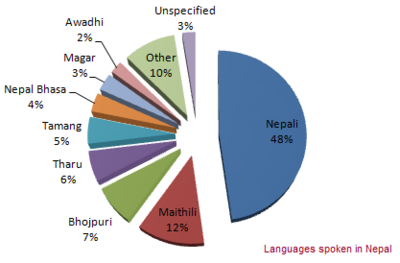
| Data | Size |
|---|---|
| Population | 28,676,547 (2005) |
| Growth Rate | 2.2% |
| Population below 14 Years old | 39% |
| Population of age 15 to 64 | 57.3% |
| Population above 65 | 3.7% |
| The median age (Average) | 20.07 |
| The median age (Male) | 19.91 |
| The median age (Females) | 20.24 |
| Ratio (Male:Female) | 1, 060:1,000 |
| Life expectancy (Average) | 59.8 Years |
| Life expectancy (Male) | 60.9 |
| Life expectancy (Female) | 59.5 |
| Literacy Rate (Average) | 53.74% |
| Literacy Rate (Male) | 68.51% |
| Literacy Rate (Female) | 42.49% |
Differences between Hindus and Buddhists have been in general very subtle and academic in nature due to the intermingling of Hindu and Buddhist beliefs. Both share common temples and worship common deities and many of Nepal's Hindus could also be regarded as Buddhists and vice versa. Gurkhas are from Nepal. Buddhism was relatively more common among the Newar. Among the other natives of Nepal, those most influenced by Hinduism were the Magar, Sunwar, Limbu and Rai. Hindu influence is less prominent among the Gurung, Bhutia, and Thakali groups, who employ Buddhist monks for their religious ceremonies.
The northern mountains are sparsely populated. A majority of the population live in the central highland despite the migration of a significant section of the population to the fertile Terai belt in recent years. Kathmandu, with a population of around 800,000 (Metropolitan area: 1,5 million) is the largest city in the country.
Culture
Nepalese culture is diverse, reflecting people of different ethnic origins. The Newar community is particularly rich in cultural diversity, hosting most of the festivals and being well known for their music and dance.
A typical Nepalese meal is dal-bhat, a kind of lentil soup served with rice, vegetables, and pickles. The Newar community, however, has its own unique cuisine. It consists of non-vegetarian and vegetarian items as well as alcoholic and non-alcoholic beverages. Mustard oil and a host of spices, such as cumin, sesame seeds, turmeric, garlic, ginger, methi (fenugreek), bay leaves, cloves, cinnamon, pepper, chili, mustard seeds, vinegar, etc. are used in cooking. The cuisine served in the festivals is considered to be the best diet cuisine.
Folklore is an integral part of Nepalese society. Traditional stories are rooted in the reality of day-to-day life—tales of love, affection, battles, and demons and ghosts; they reflect and explain local lifestyles, cultures and belief systems. Many Nepalese folktales are enacted in dance and music.
The Newar Music consists mainly of percussion instruments. Wind instruments such as flutes and similar instruments are also used. String instruments are very rare. There are songs pertaining to particular seasons and festivals. Paahan chare music is most probably the fastest played music whereas the Dapa the slowest. The dhimay music are the loudest ones. There are certain musical instruments such as Dhimay and Bhusya which are played as instrumental only and are not accompanied with songs. In the hills, people enjoy their own kind of music, playing saarangi (string instrument), madal and flute. They also have many popular folk songs like lok geet and lok dohari.
The Newar dances can be broadly classified into masked dances and non-masked dances. The most representative of Newari dance is Lakhey dance. Almost all the settlements of Newar have Lakhey dance at least once a year. Almost all of these Lakhey dances are held in the Goonlaa month. So, they are called Goonlaa Lakhey. However, the most famous Lakhey dance is the Majipa Lakhey dance. It is performed by the Ranjitkars of Kathmandu. The dance takes place during the whole week containing the full moon of Yenlaa month. The Lakhey are considered as the saviors of children.
The Nepali year begins in mid-April and is divided into 12 months. Saturday is the official weekly holiday. Main holidays include the National Day (birthday of the king) December 28, Prithvi Jayanti, ( January 11), and Martyr's Day ( February 18) and a mix of Hindu and Buddhist festivals such as dashain in autumn, and tihar late autumn. During tihar, the Newar community celebrates its New Year as per local calendar Nepal Sambat.
Most houses in rural lowland of Nepal are made up of a tight bamboo framework with mud and cow-dung walls. These dwellings remain cool in summers and retain warmth in winters. Dwellings in higher latitudes are mostly stone masonary walls with slate and thatch roof and timber based.
